SUMMARY
This is AI generated summarization, which may have errors. For context, always refer to the full article.
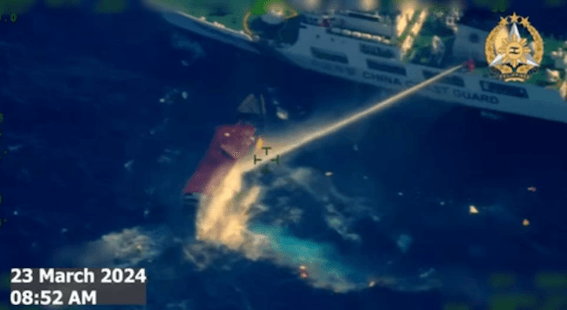
MANILA, Philippines – When the Unaizah May 4 approached Ayungin Shoal in the West Philippine Sea for a second time in a month, it was greeted by a familiar and violent foe: water cannons from the China Coast Guard (CCG).
On Saturday, March 23, out at sea, the wooden ship held on, but barely.
GMA News’ exclusive video taken from inside the Unaizah May 4 showed military personnel scrambling around an already-drenched ship deck as China’s water cannon imposed its way from one side of the ship to the other.
“Tama na, Lord (Lord, please stop this),” said one of the people in the video, before another blast of water shot through the ship.
The water cannons from the CCG went on for over an hour (according to videos from the Armed Forces of the Philippines). The Unaizah May 4 suffered “severe damage” while Navy personnel on board also reported injuries. The video taken from inside the ship would suggest it’s a miracle that nobody got seriously hurt.
China reasoned out its use of water cannons, dangerous maneuvers, and blocking to push away the much-smaller Unaizah May 4 and Philippine Coast Guard (PCG) vessels. It said its CCG and Chinese Maritime Military “firmly [obstructed] the Philippines’ vessels, and [foiled] the Philippines’ attempt.”
Manila called China out for what those actions actually were: “Illegal and irresponsible actions belies its hollow claims to peace, dialogue, and adherence to international law.”
The Philippine National Security Adviser Eduardo Año was a lot less diplomatic in his words for Beijing.
“Their actions are illegal, coercive, aggressive and even deceptive. This is just an ordinary rotation and resupply or provision operation but look at how the Chinese are reacting, it’s as if it’s already the end of the world. So it’s really humiliating themselves in front of the world,” he told the media in an interview on Sunday, March 24.

“We will continue to do this, we will not be deterred, we will not be intimidated because it is our right and we have to protect our soldiers, our sailors there at BRP Sierra Madre,” said Año, a day before he met with Executive Secretary Lucas Bersamin and other National Security Agency heads on what to recommend to the President.
We have seen the CCG chase or chase away Philippine ships in Ayungin Shoal before.
The Unaizah May 4’s sister ships, the Unaizah May 1 and Uniazah May 2, as well as the M/L Kalayaan, bare battlescars from those missions – dents and damage from collisions, allisions, and the CCG’s water cannons. All three ships are still being repaired.
But the intensity of the CCG’s actions on March 23, shown through video released by both the PCG and the Armed Forces of the Philippines (AFP) in near-real time, was difficult to watch. But if you still want to, the clip is right here:

At one point, a CCG ship sailed backwards at what looked like high-speed, in an attempt to block the Unaizah May 4.
According to the National Task Force for the West Philippine Sea, harassment began even before daybreak – CCG and CMM ships “worked in tandem” against the PCG vessels and the Unaizah May 4.
The Philippines’ Department of Foreign Affairs (DFA), freshly incensed over a Chinese official in Manila’s disclosure of confidential discussions, made three protests over the March 23 Ayungin incident – a summon in Manila, a protest in Beijing, and a phone call from Undersecretary Ma. Theresa P. Lazaro.
The mission, which happens at least once a month, is meant to bring soldiers and supplies to the BRP Sierra Madre in Ayungin Shoal, an area just over 100 nautical miles off the coast of Palawan.
The World War II-era vessel, purposefully run aground in 1999, now serves as a symbol of both the Philippines’ ingenuity and resilience, but also its military and material shortcomings.
The Manila-DC-Tokyo threesome
The latest dangerous incident in Ayungin Shoal happened just days after Secretary of State Antony Blinken’s visit to Manila and the White House’s announcement that it would be hosting in April the first-ever US-Japan-Philippines leaders summit.
The US, a treaty-ally of the Philippines, said China’s actions are “destabilizing to the region and show clear disregard for international law.” Japan, through its embassy in Manila, reiterated its “grave concern on the repeated dangerous actions by CCG in SCS which resulted in Filipino injuries.”
Blinken, in a joint presser with Philippine Foreign Secretary Enrique Manalo, said the US has a “shared concern about the PRC’s actions that threaten our common vision for a free, open Indo-Pacific, including in the South China Sea and in the Philippines exclusive economic zone.”
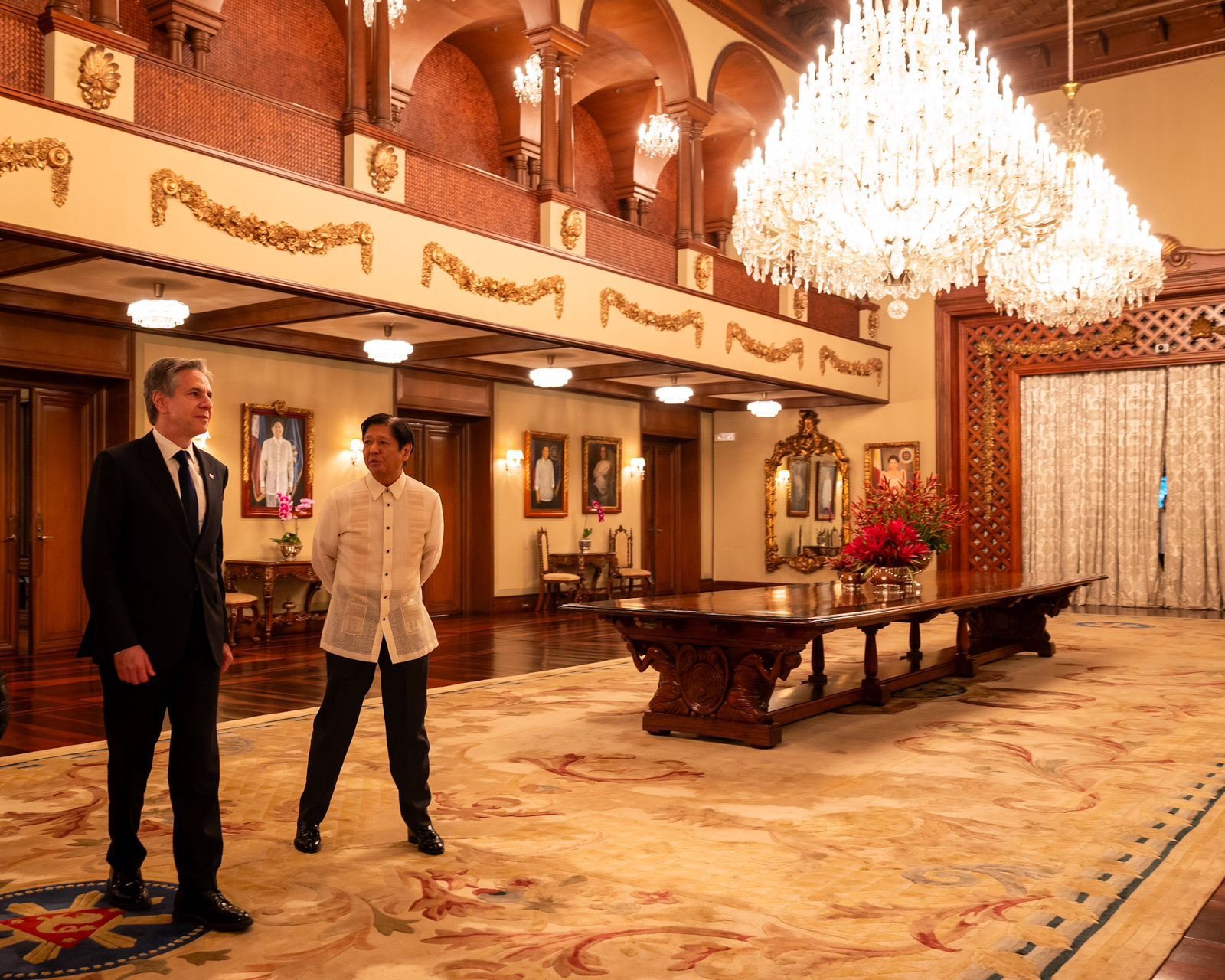
“Repeated violations of international law and the rights of the Philippines – water cannons, blocking maneuvers, close shadowing, other dangerous operations – these waterways are critical to the Philippines, to its security, to its economy, but they’re also critical to the interests of the region, the United States, and the world,” said Blinken on March 19, as he reaffirmed that the Mutual Defense Treaty would extend to armed attacks, including against the PCG, in the South China Sea.
Just two days after Blinken’s visit to Manila, Japanese Vice Foreign Minister Okano Masataka hosted Deputy Secretary of State Kurt Campbell and the Philippines’ Undersecretary Lazaro in Tokyo to “deepen trilateral cooperation among the United States, Japan, and the Philippines.”
“Deputy Secretary Campbell, Vice Foreign Minister Okano, and Undersecretary Lazaro reiterated their collective commitment to maintaining peace and security in the Indo-Pacific, including in the South China Sea and East China Sea,” the State Department said in a readout.
All eyes are on the burgeoning relationship among the three countries – a mix that would probably make the heads of Filipinos who survived the Japanese and American occupation’s spin.
But it is a relationship that makes sense, especially as tensions in the West Philippine Sea and unease over the situation in Taiwan rise. Both Manila and Tokyo are treaty allies of the United States.
Japan has had robust defense, trade, and aid ties with the Philippines, a relationship cultivated through decades and across administrations. A Reciprocal Access Agreement (RAA), a Visiting Forces Agreement-like deal that would govern how Japanese troops can engage in the Philippines, was hoped to be signed before the end of March 2024.
Washington has been quick to respond to the Marcos administration’s openness to amping up ties with one of its oldest ally. Manalo said bilateral ties are on “hyperdrive.”
Blinken said in response: “The alliance has never been stronger, but we not only have to sustain that, we have to continue to accelerate the momentum.”
And Beijing? Well, they’re certainly not enthused, as expected.
“The military cooperation between the US and the Philippines should not undermine China’s sovereignty and maritime rights and interests in the South China Sea, nor should it be used to support the illegal claims of the Philippines,” said the Chinese Foreign Ministry’s spokesperson Lin Jian, responding to Blinken’s concerns over Chinese actions in the South China Sea.
Another threesome in the making?
The Marcos administration has been on hyperdrive in improving its bilateral and multilateral ties, especially in terms of security and defense.
Lazaro, in a chance interview in early March, said there would be “no difficulties” in another trilateral relationship: between the Philippines, Japan, and India. Although no formal talks have started, Philippine-Japan ties have always been robust. Manila and New Delhi ties have only improved in recent years.
From March 25 to 27, Manila will be hosting Indian External Affairs Minister S. Jaishankar. This would be their top diplomat’s second visit to the Philippines in just over two years.
“In addition to advancing trade and tourism between two of Asia’s fastest growing economies, the foreign minister’s meeting with Secretary for Foreign Affairs Enrique A. Manalo will focus on defense and maritime cooperation, food security, development, healthcare and financial technology cooperation,” said the DFA in a release.
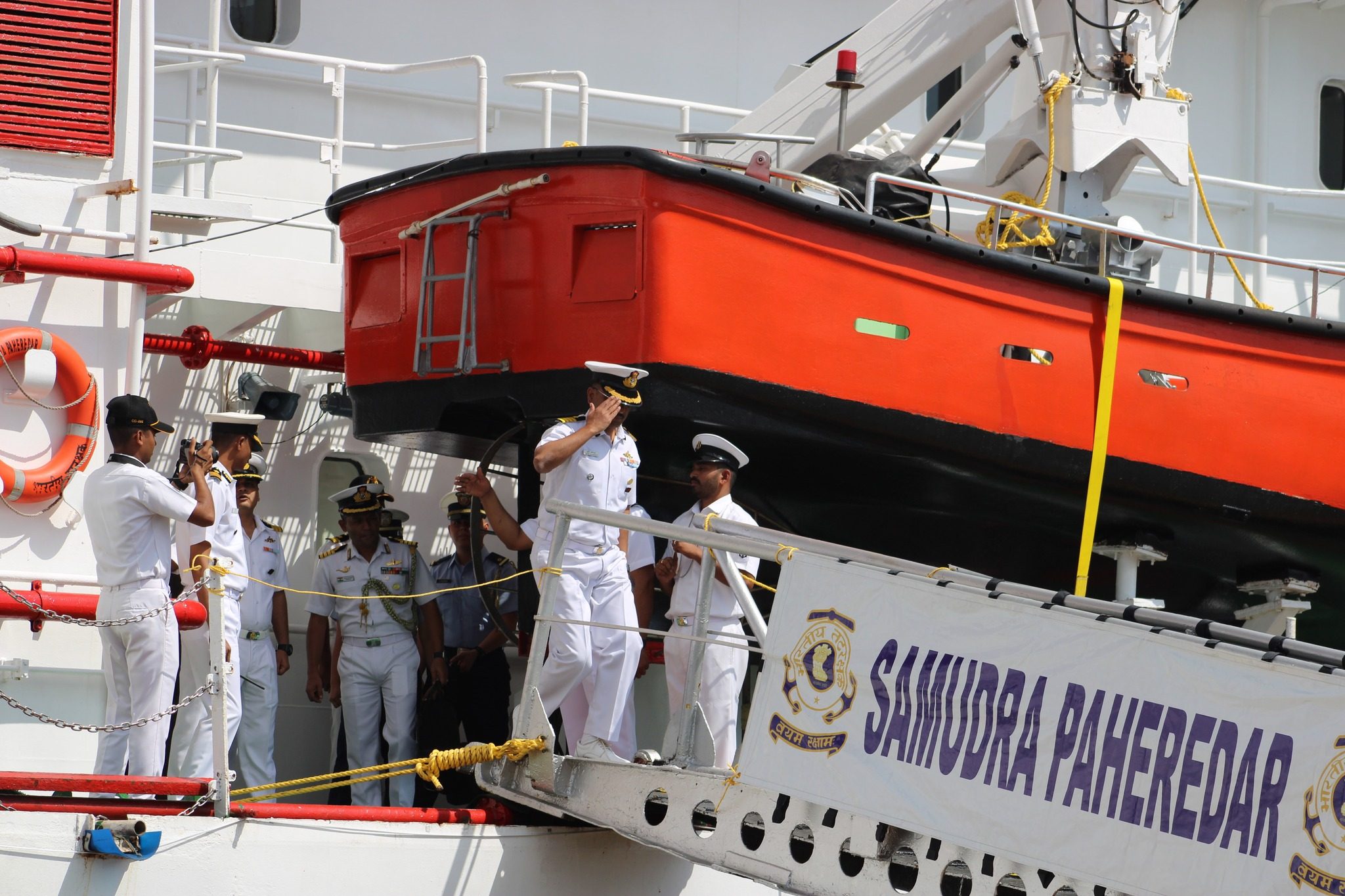
Manila is Jaishankar’s last stop in a three-country tour around the region. Indian Ambassador to Manila Shambhu S. Kumaran, speaking at the Indian Technical and Economic Cooperation 2024 Day, said bilateral ties between Manila and New Delhi were at their “best ever.”
It’s a timely visit from New Delhi – India, too, has to contend with China’s encroachment. In August 2023, it protested China’s new “standard map,” which claimed parts of Indian territory. The Philippines has long protested China’s version of reality – in particular, because in that map, almost all of the South China Sea is Beijing’s.
Cooperation between the coast guards of India and the Philippines are well and good. The two coast guards signed a memorandum of understanding for “enhancing maritime cooperation” back in August 2023.
The India Coast Guard’s Samura Pahererar is docked in Manila to coincide with Minister Jaishankar’s visit. – Rappler.com
Add a comment
How does this make you feel?
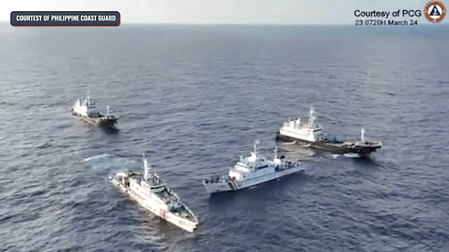



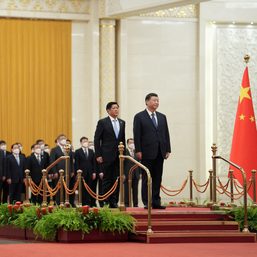

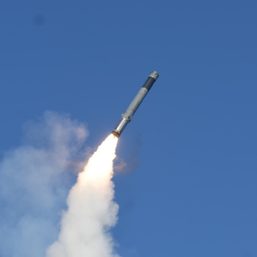

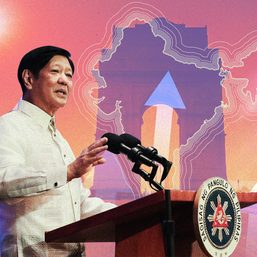
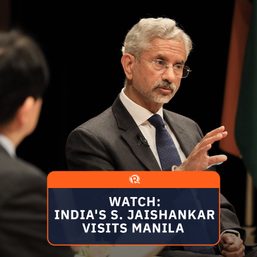
![[Hindi ito Marites] Japan: From enemy to bestie](https://www.rappler.com/tachyon/2024/07/Hindi-ito-Marites-TC-ls-7.jpg?resize=257%2C257&crop=415px%2C0px%2C1080px%2C1080px)

![[Rappler’s Best] America](https://www.rappler.com/tachyon/2024/07/rapplers-best-america.jpg?resize=257%2C257&crop=458px%2C0px%2C1080px%2C1080px)







There are no comments yet. Add your comment to start the conversation.